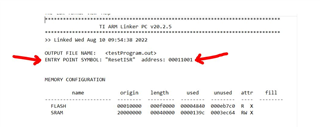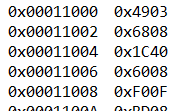HI All,
I'm trying to place my entry point function at address 0x11000. Yet the linker consistently places it at 0x11001. I get no warnings or errors during linking.
If I jump to 0x11000 (desired address), the processor crashes.
If I jump to 0x11001, the program runs properly so it appears that my entry point function is really at 0x11001.
I've included as much info as I could find to demonstrate the contradictions.
Thank you,
Peter
My linker file where I map my entry function to a section called 'myEntryPoint' and map it to address 0x11000.
SECTIONS
{
.intvecs: > 0x00010000
.text : > FLASH
.const : > FLASH
.cinit : > FLASH
.pinit : > FLASH
.init_array : > FLASH
.test : > FLASH
.vtable : > 0x20000000
.data : > SRAM
.bss : > SRAM
.sysmem : > SRAM
.stack : > SRAM
.nvv : > SRAM
myEntryPoint
{
entryPoint.obj(.text)
} > 0x11000
}
My linker configuration where I specify the name of my entry point, which is in the myEntryPoint.obj:

And sections of my map file, which has contradictory information as to the entry point:




And finally, a snapshot of the actual memory after flashing the program via CCS:



